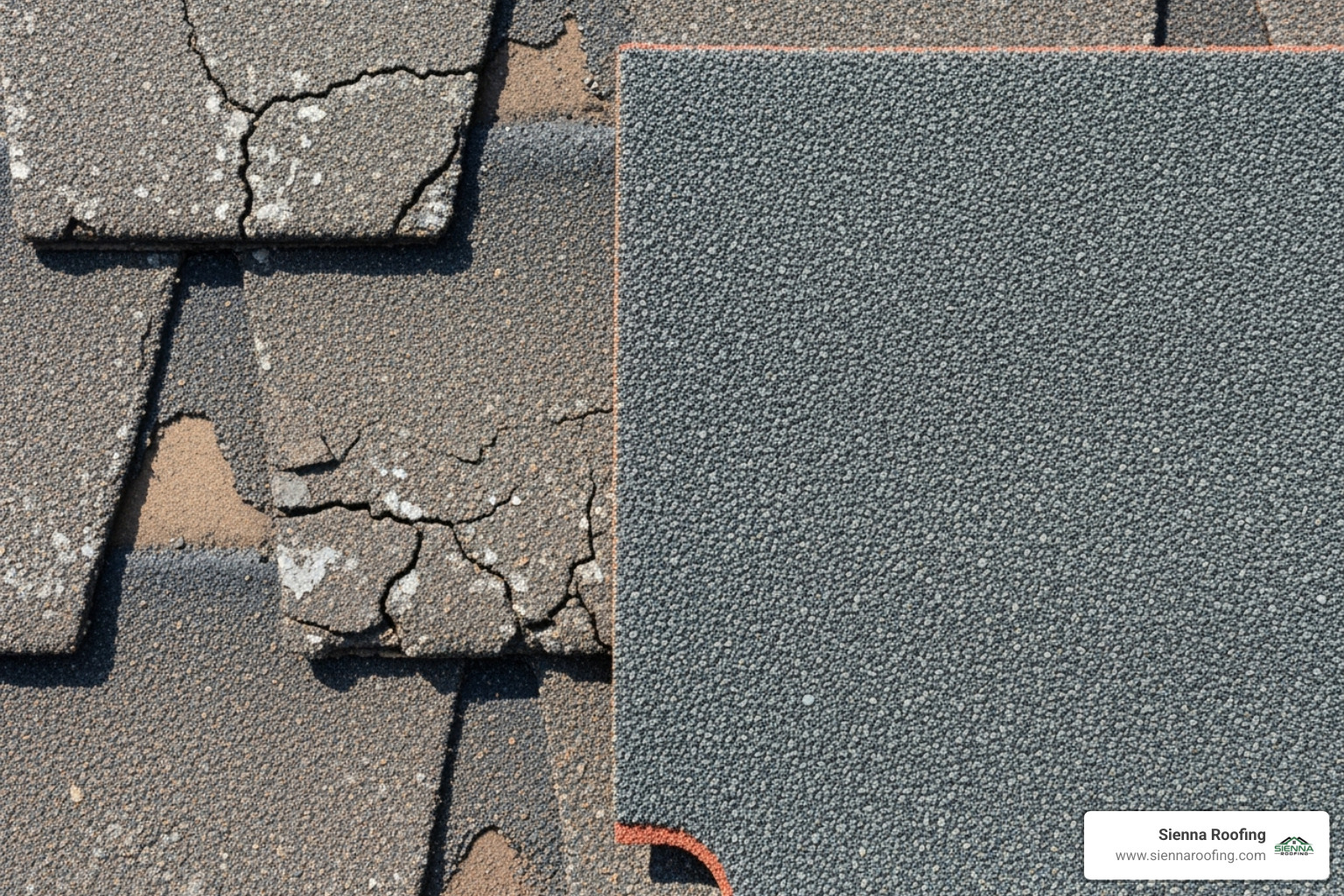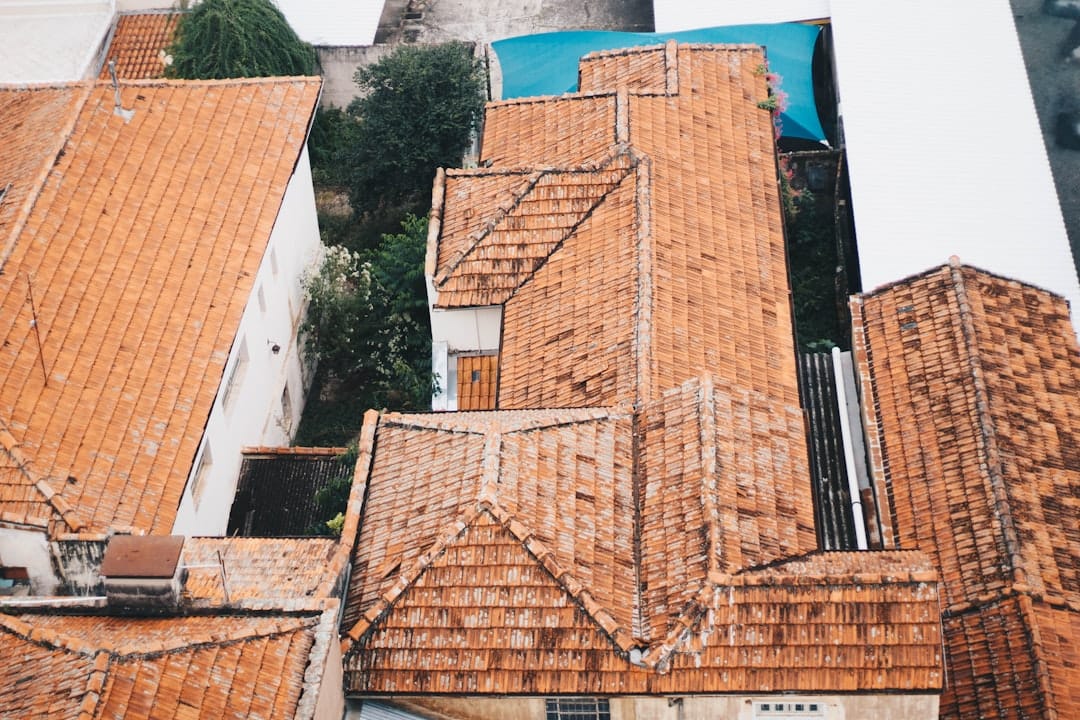What You Need to Know About Roof Replacement Costs
Roof replacement cost is typically one of the largest home improvement expenses you’ll face as a homeowner. Here’s what you need to know upfront:
National Average Cost Range:
- $6,000 – $20,000 for most homes
- $8,000 – $9,000 average cost nationwide
- $3.50 – $12.30 per square foot depending on material
Key Cost Factors:
- Roof size – Larger roofs cost more
- Material choice – Asphalt shingles vs. metal vs. tile
- Labor costs – 40-60% of total project cost
- Location – Regional pricing varies significantly
- Roof complexity – Steep slopes and features increase costs
When considering a new roof for your home, understanding these costs upfront helps you budget properly and avoid sticker shock. The reality is simple: putting off a necessary roof replacement often leads to more expensive repairs down the road.
Your roof protects everything you value most. A leaking or failing roof can cause thousands in water damage to your home’s structure, belongings, and electrical systems. That’s why smart budgeting for this major investment is so important.
I’m Andre Castro, CEO and founder of Sienna Roofing. With over five years of experience helping Houston Metro area homeowners with roof replacement cost decisions and a Construction Management background from Texas A&M, I’ve seen how proper planning leads to successful roofing investments.

Decoding Your Estimate: The 7 Key Factors Driving Roof Replacement Cost
Ever wonder why roof replacement cost estimates can vary so dramatically between homes? It’s not just contractors throwing numbers around – there are specific factors that drive these prices. Think of your roofing estimate like a recipe. Each ingredient (or factor) contributes to the final result, and understanding these components helps you make informed decisions about your investment.
Let me walk you through the seven key factors that determine what you’ll pay for your new roof. Once you understand these elements, those estimate numbers will start making a lot more sense.
How Roof Size and Complexity Impact Your Final Bill
Here’s where things get interesting. Yes, bigger roofs cost more – but it’s not just about square footage. Roofers measure in “squares,” where one square equals 100 square feet. So your 2,000 square foot home actually needs about 20 squares of materials.
But here’s the kicker: roof complexity can make a simple job expensive fast. A steep roof with a 12:12 pitch (that’s a 45-degree angle) takes twice as long to work on as a gentle slope. Your crew needs more safety equipment, moves slower, and faces higher risk.
Features that bump up your costs:
- Dormers that create multiple angles
- Skylights requiring precise cutting and sealing
- Chimneys needing custom flashing work
- Multiple valleys where water collects
Each of these elements means more careful work, more material waste from cuts, and more time on the job. A simple ranch-style roof might cost $8,000, while a Victorian with multiple dormers and steep slopes could easily hit $15,000 using the same materials.
Labor and Installation: The Human Element (40-60% of Total Cost)
Here’s something that surprises many homeowners: labor typically represents 40-60% of your total roof replacement cost. That skilled crew working on your roof isn’t just nailing down shingles – they’re performing precision work that protects your biggest investment.

Professional roofers charge between $40-$90 per hour per worker, and for good reason. They’re handling the complete tear-off process – removing your old roof down to the deck, disposing of debris, and installing everything fresh. This tear-off adds $0.40-$2.00 per square foot but ensures your new roof has the best foundation possible.
Debris disposal alone can cost $665-$3,343 for a typical home. Some contractors might suggest an overlay (new shingles over old), but experienced professionals know this shortcuts often lead to problems down the road.
The contractor’s experience also affects pricing. A seasoned crew with proper safety equipment and insurance might cost more upfront, but they’ll complete the job efficiently and stand behind their work with comprehensive warranties.
Uncovering Hidden Damage: The State of Your Roof Decking
Sometimes the biggest surprises come from what you can’t see. When your old shingles come off, hidden damage to the roof decking can significantly impact your roof replacement cost. This wooden foundation supports everything, and water damage or rot can compromise your entire roofing system.
Decking repair costs range from $2.20-$3.00 per square foot. Small areas of isolated rot might only cost $100-$500 to patch, but extensive water damage requires replacing entire sections. Skipping necessary decking repairs is like building a house on a shaky foundation – it’ll cause problems later.
Structural integrity issues must be addressed before new materials go on. Yes, it adds to your immediate costs, but it’s essential for a roof that’ll last decades. For more insights on when repairs might be sufficient versus full replacement, check out The Ultimate Guide to Roof Repair Cost: What to Expect in 2025.
How Your Location in the Houston Area Affects Pricing
Location absolutely matters when it comes to roof replacement cost. Here in the Houston Metro area, including Sugar Land, Katy, and surrounding communities, several local factors influence your final price.
Local labor rates reflect our area’s cost of living and demand for skilled trades. Permit fees typically add $200-$500 to your project, but they ensure your roof meets local building codes and safety standards.
Our climate demands special consideration too. Hurricane-rated materials cost more upfront but provide crucial protection during storm season. The intense Texas heat and humidity also require specific underlayment and ventilation systems that perform well in our conditions.
For homeowners in our area, these localized factors mean getting estimates from contractors who understand regional requirements is essential. If you’re considering Roof Replacement Sugar Land, working with a local team familiar with area-specific challenges ensures your investment is properly protected.
Understanding these seven factors helps you evaluate estimates more effectively and budget appropriately for your roofing project. The lowest bid isn’t always the best value – focus on contractors who address all these elements transparently in their proposals.
Material Matters: A Breakdown of Roofing Costs by Type
The material you choose is one of the biggest decisions you’ll make, affecting both the upfront cost and the long-term performance of your roof. Think of it like choosing the foundation for your home’s protection – you want something that fits your budget today while serving you well for decades to come. Let’s explore the most popular options and what you can expect to invest.
Asphalt Shingles: The Popular and Affordable Choice
There’s a reason you see asphalt shingles on most homes across America – they simply work! These versatile shingles offer an unbeatable combination of affordability, reliability, and curb appeal that makes them the go-to choice for homeowners looking to balance roof replacement cost with quality.

When it comes to pricing, architectural asphalt shingles typically run between $4.50 to $8 per square foot installed. For a standard 2,000 square foot roof, you’re looking at somewhere between $9,000 and $16,000 for the complete installation. That’s a pretty reasonable investment for a roof that will protect your family for the next 25-30 years.
Here’s something important to understand: not all asphalt shingles are created equal. While basic 3-tab shingles might seem cheaper upfront, architectural shingles are worth the extra investment. They’re thicker, more durable, and offer better wind resistance – crucial here in Texas where storms can pack a punch. Plus, they have that dimensional look that really improves your home’s appearance.
For most homeowners seeking quality residential roofing, architectural asphalt shingles hit that sweet spot of performance and value. They’re especially smart if you’re planning to stay in your home for many years to come.
Metal Roofing: Durability Meets Modern Style
Metal roofing has really taken off in recent years, and once you understand the benefits, it’s easy to see why. Yes, the initial roof replacement cost is higher than asphalt, but when you factor in longevity and energy savings, metal roofing often pays for itself over time.
You’ll find two main types of metal roofing systems. 5V metal roofing costs between $7 to $19 per square foot, which translates to $14,000 to $38,000 for a 2,000 square foot roof. Standing seam metal roofing runs a bit higher at $10 to $23 per square foot, or $20,000 to $46,000 for that same sized roof.
But here’s where metal roofing really shines: longevity. These roofs commonly last 50-75 years, with some standing seam systems reaching up to 70 years. Compare that to the 25-30 years you’ll get from asphalt, and suddenly that higher upfront cost makes more sense. Plus, you’ll see a solid 48.1% return on investment when it’s time to sell your home.
The energy efficiency benefits are particularly valuable here in our hot Texas climate. Metal roofs excel at reflecting solar heat, which can significantly reduce your cooling costs during those sweltering summer months. They’re also incredibly resilient against hurricanes and severe weather – something every Houston area homeowner can appreciate.
Tile and Slate: The Premium, Long-Lasting Options
If you’re looking for the ultimate in durability and distinctive style, tile and slate roofs represent the premium end of roofing materials. These options come with a higher roof replacement cost, but they’re truly generational investments that can outlast the homeowner.
Concrete tile is the more accessible option, running $7 to $19 per square foot (that’s $14,000 to $38,000 for a 2,000 square foot roof) and typically lasting around 50 years. Clay tile steps up the game at $12 to $21 per square foot ($24,000 to $42,000 for 2,000 square feet) but can last over a century with proper maintenance.
At the top of the pyramid sits slate roofing, costing $23.49 to $31.77 per square foot. For a 1,700 square foot roof, you’re looking at $39,925 to $54,020. But here’s the incredible part: a quality slate roof can last 125 to 200 years. That’s literally a roof your great-grandchildren might inherit!
One important consideration with these heavier materials is structural support. Your home may need additional reinforcement to handle the extra weight, which can add to the overall project cost. However, for homeowners who want best durability and timeless beauty, these materials deliver exceptional value over their extended lifespan.
Additional Material Costs to Consider
Your roof is more than just the visible shingles or tiles – it’s a complete system with several crucial components that affect your total roof replacement cost. Understanding these “behind-the-scenes” elements helps you budget accurately and ensures your new roof performs at its best.
Underlayment serves as your roof’s first line of defense, installed directly on the decking before your main roofing material. This protective barrier costs between $1.50 and $2.10 per square foot and is absolutely essential for moisture protection.
Ice and water shield provides extra protection in vulnerable areas like valleys and eaves. While more critical in colder climates, it’s beneficial everywhere and runs between $1.87 and $2.53 per square foot before installation costs.
Flashing might seem like a small detail, but it’s crucial around chimneys, skylights, and vents. These thin metal plates prevent leaks at roof penetrations and typically cost $9.00 to $11.00 per linear foot.
Don’t overlook proper ventilation – it’s critical for extending your roof’s life and improving energy efficiency. Good airflow prevents heat and moisture buildup that can cause premature aging and even mold problems.
Finally, consider gutters and related components. While not technically part of the roof, new gutters are often installed during replacement. Fascia board replacement runs $4.25 to $8.62 per linear foot, while soffits cost $2.80 to $5.28 per linear foot.
These components work together to create a complete roofing system that protects your home effectively. Investing in quality materials for these “invisible” elements ensures your beautiful new roof performs reliably for decades to come.
Repair or Replace? 7 Telltale Signs Your Roof is Done
Knowing when to opt for a full replacement versus a simple repair can save you thousands in the long run. Trying to patch up a roof that’s truly at the end of its life is like putting a band-aid on a dam – it might hold for a bit, but a bigger problem is inevitable. Watch for these critical warning signs that indicate your roof is ready for retirement.

- Advanced Age: If your roof is over 20 years old, especially if it’s asphalt shingles (which typically last 15-30 years), it’s likely nearing the end of its functional life. Even if it looks okay, materials degrade over time.
- Widespread Damage: Are shingles curling, cracking, or buckling across large areas of your roof, not just isolated spots? This indicates widespread material fatigue and deterioration, making a full replacement more cost-effective than continuous repairs.
- Bald Spots: You find excessive shingle granules (the gritty material that protects shingles from UV rays) in your gutters or around your downspouts. This means your shingles are losing their protective coating and are nearing the end.
- A Sagging Roofline: A visibly drooping or sagging roof deck indicates a serious structural issue, possibly due to water damage or rot in the underlying decking or trusses. This is a critical sign that requires immediate attention and likely a full replacement.
- Persistent Leaks: One or two isolated leaks might be repairable. But if you have multiple or recurring leaks, especially in different areas, it suggests a systemic failure of your roofing system.
- Moss or Algae Growth: While some moss or algae can be cleaned, extensive growth, particularly in humid climates like ours, can trap moisture against the shingles and accelerate their deterioration. If it’s pervasive, it’s a sign of a compromised roof.
- Neighbors Are Replacing: If homes built at the same time as yours in your neighborhood are getting new roofs, it’s a strong indicator that your roof is likely due for replacement as well. Houses in the same area often experience similar wear and tear from weather and age.
Smart Spending: How to Finance and Save on Your New Roof
A new roof is a major expense, but there are several ways to make it more manageable and ensure you get the best value for your investment. The good news? You don’t have to drain your savings account or put off this critical home improvement. Let’s explore your options for making roof replacement cost work within your budget.
Exploring Your Payment and Financing Options
When facing a significant roof replacement cost, you have more financing options than you might think. The key is finding the right approach that fits your financial situation and timeline.
Insurance claims can be your biggest ally if your roof sustained damage from a recent storm, hail, or strong winds. Here in Texas, we see plenty of weather-related roof damage, and your homeowners insurance might cover a substantial portion of the replacement cost. At Sienna Roofing, we specialize in working with insurance companies to help you steer the claims process efficiently, taking the headache out of dealing with adjusters and paperwork.
Personal loans offer another straightforward path to funding your roof replacement. These unsecured loans typically come with fixed interest rates and predictable repayment terms, so you’ll know exactly what you’re paying each month. They’re particularly useful when you need funds quickly and don’t want to use your home as collateral.
If you’ve built up equity in your home, home equity loans or HELOCs (Home Equity Lines of Credit) can provide access to larger amounts at lower interest rates. Since your home serves as collateral, lenders view these as less risky, which translates to better rates for you. This option works especially well for homeowners who’ve owned their property for several years.
Don’t overlook government assistance programs either. Agencies like the U.S. Department of Agriculture (USDA) and the U.S. Department of Housing and Urban Development (HUD) sometimes offer grants or low-interest loans for critical home repairs, including roofing. These programs are particularly helpful for low-income homeowners who might not qualify for traditional financing. You can explore these options at USA.gov’s home repair resources.
Many reputable roofing companies, including our team at Sienna Roofing, also offer contractor financing options or partnerships with lenders. These arrangements can streamline the process and sometimes offer promotional rates or flexible terms custom specifically for home improvement projects.
Pro Tips for Reducing Your Overall Roof Replacement Cost
While a quality roof is an investment you shouldn’t skimp on, there are smart strategies to help you save money without compromising on quality or workmanship.
Getting multiple quotes is absolutely essential. Always obtain at least three detailed, itemized quotes from different reputable roofing contractors. This isn’t just about finding the lowest price – it’s about comparing pricing, materials, warranties, and proposed scopes of work to ensure you’re getting fair value. Look for contractors who provide transparent, detailed estimates that break down labor, materials, and any additional costs.
Timing can save you money too. If your roof replacement isn’t an emergency, consider scheduling it during off-peak seasons like late fall or winter. Contractors often have less demand during these times and may offer more competitive pricing or faster scheduling. Plus, you’ll likely get more personal attention when crews aren’t juggling multiple urgent projects.
Regular maintenance is one of the best investments you can make in extending your roof’s life. A well-maintained roof can last significantly longer than one that’s neglected. Schedule inspections every 1-3 years, keep gutters clean, trim overhanging branches, and address minor repairs promptly. These small steps can prevent issues from escalating into costly full replacements.
When selecting materials, think about long-term value rather than just upfront costs. While premium materials like metal or tile have higher initial costs, their extended lifespan and durability can offer significant long-term savings by delaying future replacements. Consider the total cost of ownership over the roof’s lifetime – sometimes spending more now actually saves money in the long run.
Name: Sienna Roofing
Address: 17034 University Blvd, Sugar Land, TX 77479
Phone: (832) 564-3322
Frequently Asked Questions about Roof Replacement Costs
We get these questions almost daily from homeowners in the Houston area who are trying to wrap their heads around roof replacement cost. Let me share the answers to the most common ones – these might address some of your own concerns!
How much does a roof replacement cost for a 2,000 sq. ft. house?
This is probably our most-asked question, and honestly, it’s like asking “How much does a car cost?” – it really depends on what you’re looking for! For a 2,000 square foot house, your roof replacement cost can swing pretty dramatically based on your material choice.
If you go with architectural asphalt shingles (our most popular option), you’re looking at somewhere between $9,000 and $16,000. That’s a solid middle-ground choice that gives you great bang for your buck. But maybe you’re thinking bigger picture – a standing seam metal roof will run you $20,000 to $46,000, which sounds like a lot until you realize it could last 50-70 years.
Concrete tiles fall in the middle range at $14,000 to $38,000, while clay tiles bump up to $24,000 to $42,000. These figures include both materials and labor, but your specific costs might vary depending on how complex your roofline is and exactly where you are in the Houston Metro area.
Does a new roof increase my home’s value?
Oh, absolutely! This is one of those home improvements that actually pays you back. A new roof doesn’t just make your house look amazing from the curb – it gives potential buyers that warm, fuzzy feeling that the home has been well-cared for.
The numbers are pretty encouraging too. A new asphalt shingle roof typically delivers a 56.9% return on investment, while metal roofing provides about 48.1% ROI. But here’s the thing – it’s not just about the dollars and cents. A new roof signals to buyers that they won’t have to worry about leaks, repairs, or replacement for years to come. That peace of mind can make your home stand out in a competitive market and potentially sell faster.
Plus, let’s be honest – there’s nothing that kills a home’s curb appeal quite like a tired, worn-out roof. A fresh roof can completely transform how your house looks from the street.
How long does a typical roof replacement take?
Most homeowners are surprised by how quickly we can transform their roof. The actual tear-off and installation typically takes anywhere from 1 to 5 days for most residential projects. A straightforward ranch-style home might be done in a day or two, while a complex roof with multiple angles, dormers, and features could stretch to a week.
But here’s what that timeline doesn’t include – the whole process from start to finish involves a few more steps. There’s the initial inspection and quote, getting your permits approved (which can take a week or two), and scheduling the work around weather and our crew availability. Weather delays are always a possibility, especially during our stormy season here in Texas.
We always keep our customers in the loop about realistic timelines and any potential delays. Nobody likes surprises when it comes to having workers on their roof!
Conclusion
Planning for a roof replacement cost might feel overwhelming at first, but now you have the knowledge to make smart decisions about this major investment. The key is understanding that while national averages give you a starting point, your specific situation – from the size and complexity of your roof to the materials you choose and your location here in the Houston area – will ultimately determine your final cost.
Remember the main factors we’ve covered: Your roof’s size and features drive material needs and labor time. The materials you select, whether affordable asphalt shingles or premium metal roofing, significantly impact both upfront costs and long-term value. Labor typically represents 40-60% of your total project cost, and local factors like building codes and climate requirements here in Texas play important roles too.
The most important takeaway? A professional inspection is the only way to get a truly accurate price for your specific home. Every roof tells its own story, and hidden issues like decking damage or structural concerns can only be found by experienced eyes.
Don’t let the investment intimidate you. A quality roof replacement protects everything you value most – your family, your belongings, and your home’s structural integrity. When you work with a trusted local contractor who understands our unique Texas climate and building requirements, you’re making an investment that will protect your home for decades to come.
Ready to take the next step? For a comprehensive and transparent estimate custom to your specific project, contact the experts at Sienna Roofing to learn more about our roofing services. We’re here to guide you through every step of the process, from initial inspection to final cleanup, ensuring your roof replacement experience is as smooth and stress-free as possible.




